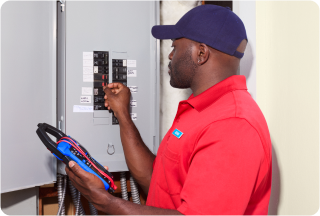How to Reset a Circuit Breaker

Did you have a power outage? Need to know how to reset your circuit breaker at home? Get these great quick tips from Home Matters.


Did you have a power outage? Need to know how to reset your circuit breaker at home? Get these great quick tips from Home Matters.
When a circuit in your home becomes overloaded or shorts out, the circuit breaker will trip and cut power to prevent electrical hazards, fire and possible electrocution. But don't sweat it — learning how to reset your circuit breaker is easy.
Steps to Reset a Circuit Breaker
1. Turn off or disconnect in area of house that lost power
Before you head to reset your circuit breaker, turn off all light switches and unplug, turn off or disconnect important appliances and devices in the area of your home that has lost power. This will prevent damage when the power is reset. Don’t forget to save any files before disconnecting your computer.
2. Find the circuit breaker box
It's usually located wherever power enters the home — try the basement, garage, or utility closet. If this outage has left you in the dark, be sure to grab a flashlight before you go searching for the box.
3. Open the cover
Open the circuit breaker box, but never touch the box with wet hands or remove the cover. You’ll be able to identify the tripped breaker in one of a few ways. Look for a switch that is not in the on position. In fact, this switch could be anywhere between the on and off positions. Some circuit breakers will have a bit of orange or red next to them to indicate they’ve been tripped. If any part of the box feels hot, do not flip the switch. Leave it alone and call an electrician.
4. Reset the circuit breaker
When you reset the breaker, use one hand and stand to the side to avoid electrical issues arcing in case the breaker malfunctions. First, flip the breaker to the off position. This might seem counterintuitive, but the switch has to be turned off before it can be turned on again. You should hear a click as the switch flips into place. Then flip it from off to the on position. Again, you should hear a distinct click as it snaps into place.
Finally, head back inside the house and make sure the power is back on.
Thinking about coverage?
Security for your home. Protection for your budget.
Troubleshooting Circuit Breaker Problems
If this step-by-step guide for resetting circuit breakers has not solved your problem and your power has not returned, go back to the breaker box and flip the switch off and then on again one more time. If the power still doesn’t come back on or if the breaker shuts off again, there could be a number of things tripping the circuit breaker. You may have a short or some other issue that needs to be addressed by a professional electrician.
Related: Electrical Safety Tips for Your Home
See how a home warranty can help with covered repairs to your main breaker or fuse panel box.

AHS assumes no responsibility, and specifically disclaims all liability, for your use of any and all information contained herein.
Have a plan for your home when things don't go according to plan
Shop Home Warranties